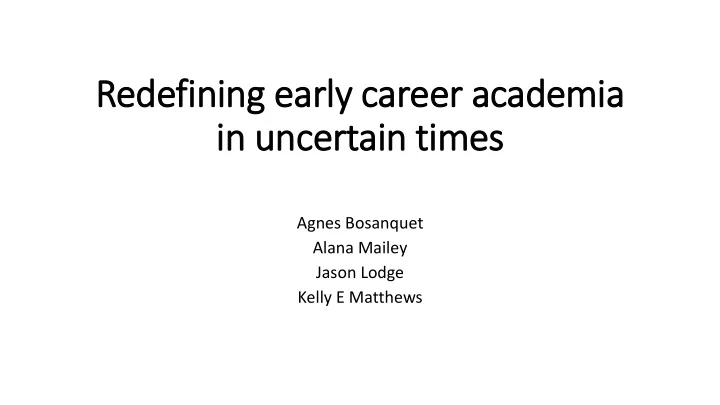

Redefining early career academia in in uncertain tim imes Agnes Bosanquet Alana Mailey Jason Lodge Kelly E Matthews
Context • ‘Early career’ academia typically defined as five years post-PhD • Terms include neophyte (Hemmings & Kay 2010), apprentice (Laudel and Glaser 2008), gen X faculty (Matross Helms 2010), young, new or junior academics (Price, Coffey & Nethery 2014). • Normative pathway: PhD, post-doc or Level A, Level B appointment or promotion • Does not reflect the lived experiences of self-defining ECAs
Method • Online qualitative and quantitative survey: 522 early career academics (ECAs) across three Australian universities • Open ended questions on career plans, ideal academic role, most and least important factors for career progression • Institutional data: professional development offered to ECAs at same three universities • Narrative inquiry = makes meaning of lived experiences through story-telling (Connelly and Clandinan, 1990)
Institutional definitions of early career Institution 1 Institution 2 Institution 3 Someone who is within his/her first An early career researcher (researchers An ECR is within five years of the start eight years of academic employment who are within five years post of their research careers. This usually (research and/or teaching), allowing for completion (formal award) of their PhD means that they have been awarded a uninterrupted, stable academic or MPhil degree PhD or equivalent research doctorate development. within five years; however, an extension to this limit would be approved owing to career interruptions (eg maternity leave, illness). DECRA Researchers may be eligible to apply if they have been awarded a PhD within five years or, together with periods of significant career interruption, have been awarded a PhD within nine years of the closing time of submission of Proposals. NHMRC Applicants must: have held their PhD for no more than two years (from the date of the letter advising that their PhD thesis was passed – not upon receipt of degree) unless career disruptions exist.
A tale of three universities: Survey findings Institution 1 Institution 2 Institution 3 In order to be successful in Academia, I need to focus on my: Research 93.70% 95% 95.30% Teaching 42% 48.30% 68.20% My first priority is: Research 68.10% 64.40% 42.40% Teaching 16% 26.70% 51.80% I am active in the scholarship of: Research 82.80% 82.80% 74.10% Teaching 30.70% 46.10% 65.90% I have participated in professional development in: Research 53.80% 42.20% 58.80% Teaching 48.70% 59.40% 77.60% My institution supports my: Research 70.80% 65.20% 67.80% Teaching 39.60% 44.00% 65.50% I am given sufficient resources to adequately conduct my: Research 57.50% 52.20% 41.40% Teaching 37.90% 42.40% 55.20%
A tale of three universities: Institutional support Institution 1 Institution 2 Institution 3 Short workshop - research Short workshop - teaching Short workshop - leadership Short workshop - career planning Professional development program Grants - internal, research Grants - internal, teaching Grants - external, research Grants - external, teaching Job opportunities/ targeted positions Seminars/ conferences Mentoring program Networking, facilitated Community of practice Induction and orientation Awards - research Awards - teaching
Redefining early career: narratives Narratives aim to capture the “messiness” of academic practice (Jones, 2011) ECA 1 – was professional staff, recently started PhD ECA 2 – career change from industry, three year Lecturer contract ECA 3 – has PhD, young family, Level B on probation ECA 4 – casual teaching at different universities since PhD completion ECA 5 – fixed-term research contract, considering leaving academia
Implications • Defining and supporting ECAs is complex • Need for subjective definitions • Uncertainty and insecurity: casualisation • Workloads and work/life balance: ‘sacrifice’, caring responsibilities (25%), administration • Research pressures: publish or perish • Love for academic work • Need for professional development and institutional support for self-defining ECAs
References • Hemmings, B. and R. Kay. 2010. Research self-efficacy, publication output, and early career development. International Journal of Educational Management 24,(7): 562-74. • Jones, A. 2011. Seeing the messiness of academic practice: Exploring the work of academics through narrative. International Journal for Academic Development 16,(2): 109-18. • Laudel, G. and J. Glaser. 2008. From apprentice to colleague: The metamorphosis of early career researchers. Higher Education 55,(3): 387-406. • Matthews, K.E., J.M. Lodge and A. Bosanquet. 2014. Early career academic perceptions, attitudes and professional development activities: Questioning the teaching and research gap to further academic development. International Journal for Academic Development 19,(2): 112-24. • Matross Helms, R. 2010. New challenges, new priorities: The experience of generation x faculty. A study for the collaborative on academic careers in higher education (Coache). • Price, E., B. Coffey and A. Nethery. 2014. An early career academic network: What worked and what didn’t. Journal of Further and Higher Education : 1-19. • Images: http://blasst.edu.au/cartoons.html
Recommend
More recommend